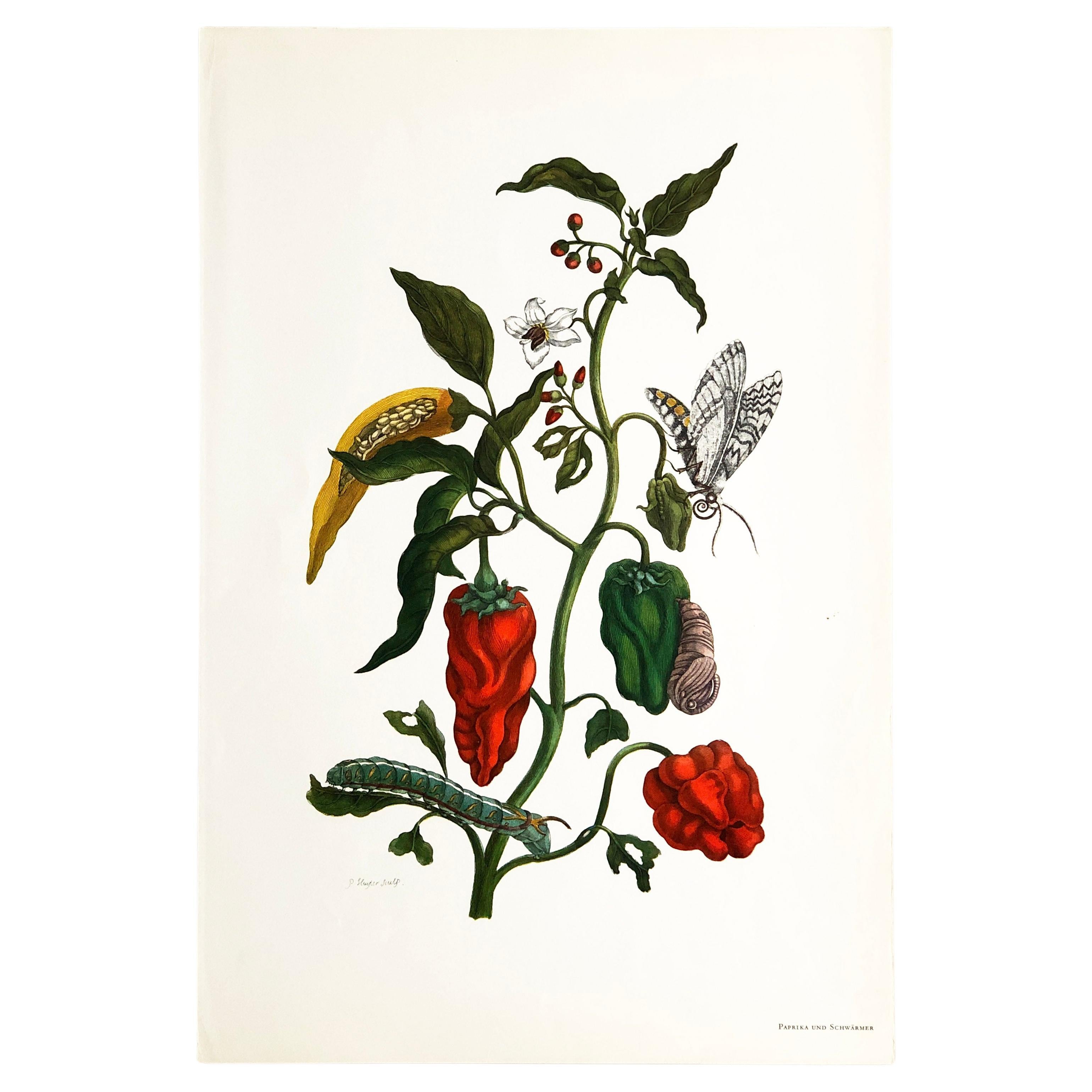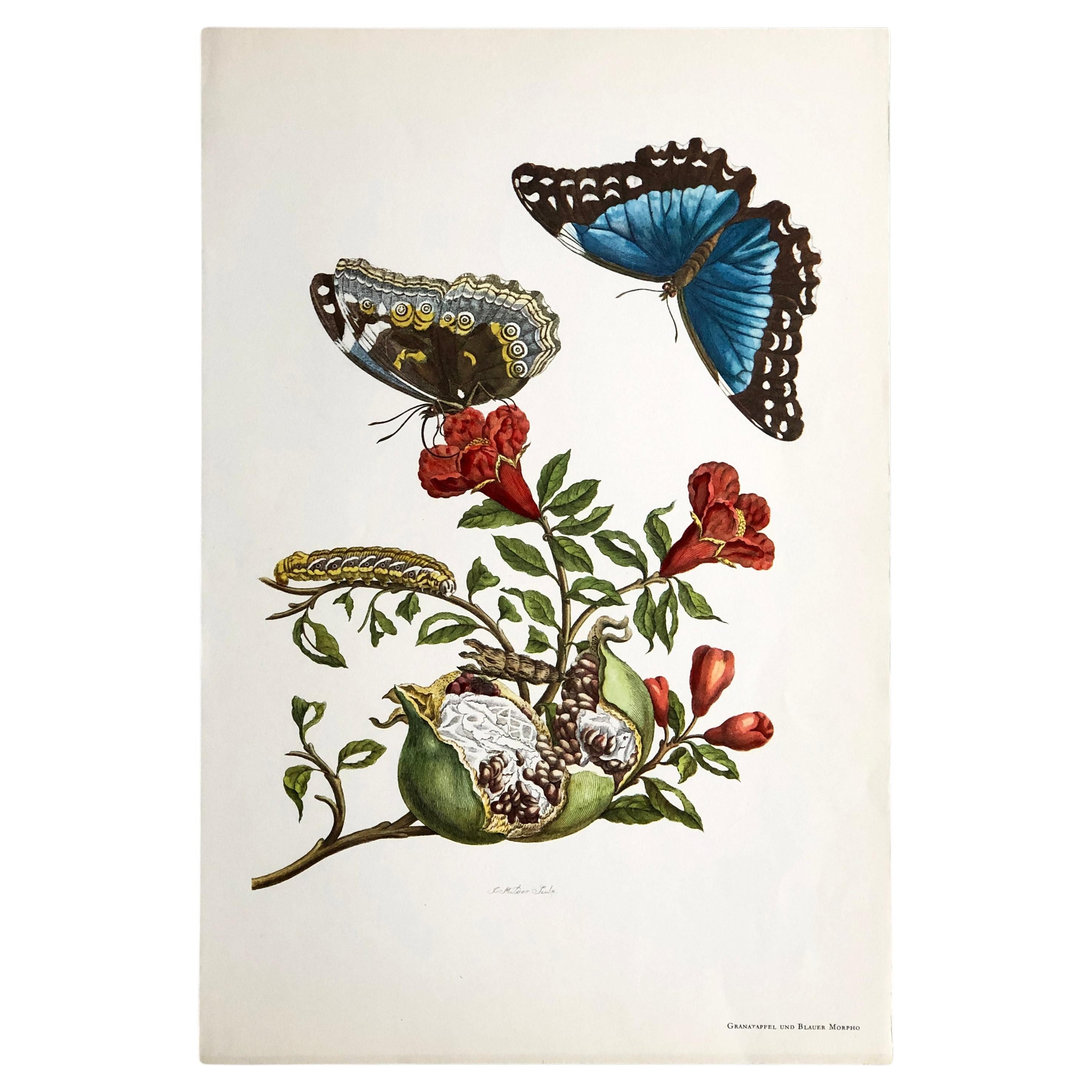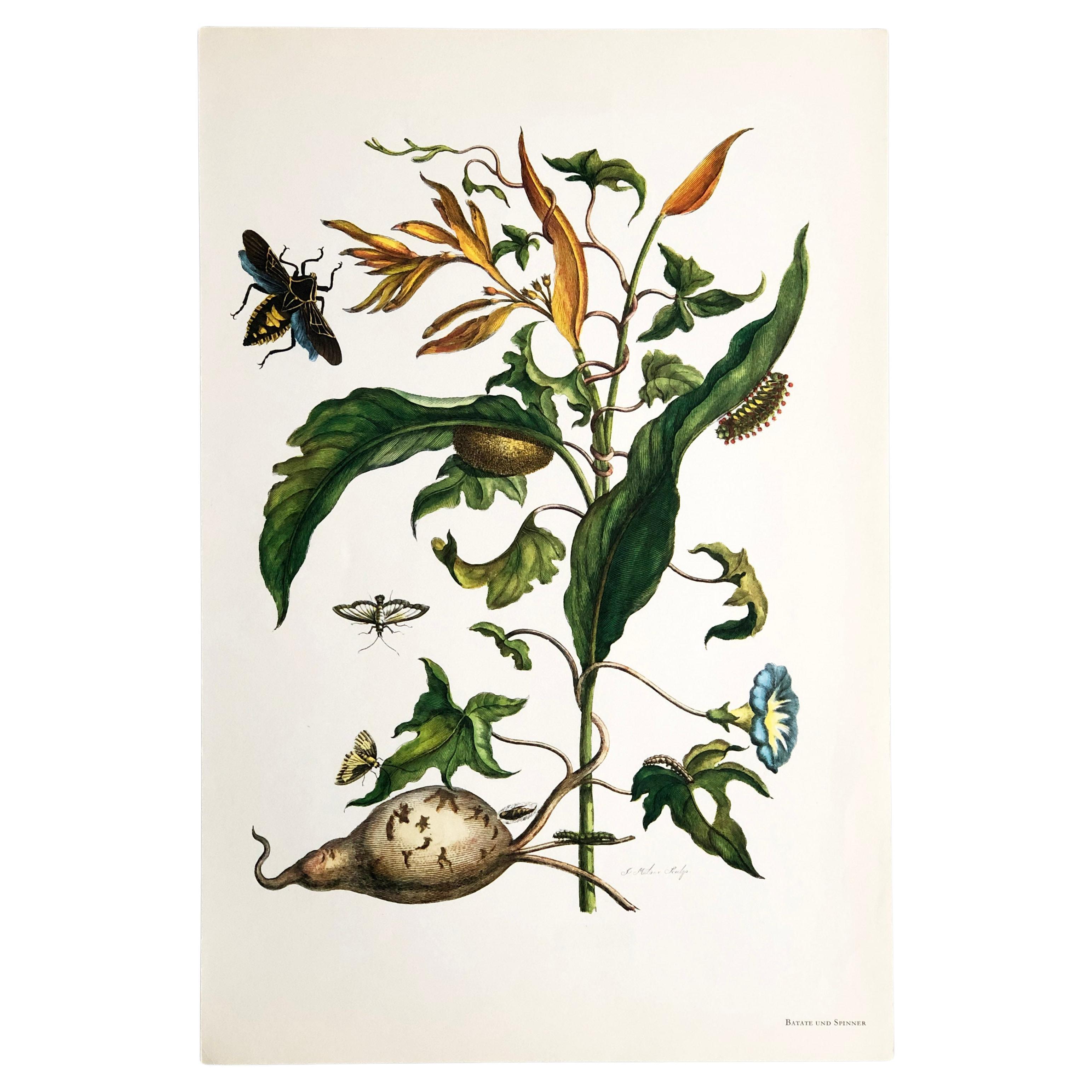Items Similar to Maria Sibylla Merian - Coral Tree and Silk Moth Nr. 11
Video Loading
Want more images or videos?
Request additional images or videos from the seller
1 of 13
Maria Sibylla Merian - Coral Tree and Silk Moth Nr. 11
About the Item
From Metamorphosis Insectorum Surinamensium, first published 1705
Engravings by J. Mulder, P. Sluyter (Sluiter) and D. Stoopendaal after Maria Sybilla Merian.
This plate is part of a comprehensive collection comprising 17 plates. Check out other listings to view the entire series.
1964 Hoffman and Campe Verlag, Hamburg Complete production Mladinska Knjiga, Ljubljana/Yugoslavia.
This 1964 official reproduction table come from the editions: Dissertation sur la génération et les transformations des insectes de Surinam, The Hague, Pierre Gosse, 1726, and Over de Voortteeling en Wonderbaerlyke Veranderingen der Surinaamsche insects, Amsterdam, Jean Frederic Bernard, 1730.
CORAL TREE AND SILK MOTH
The plant is Erythrina glanca, the blue-green coral tree, easily recognized as a legume by its fruits, called Koffiemama by the Surinamese Dutch because it is used as a shade tree in coffee and cocoa plantations. Both crops do not tolerate the direct rays of the tropical sun well. Erythrina is also called pallisade booms because the Indians split the logs and build huts and walls from the boards. The inflorescences are so heavy that the branches are pulled against the ground and only stand up again when the petals fall off. The ripe fruit cluster has pods like a broom and also serves this purpose among the natives. If the sheet with the pomegranate (original plate no. 9) lived in the tension of red and blue, one can speak less of tension here, one must speak of a moving fullness of life, which is expressed in green, yellow and brown along the two diagonals is formed by the branch, the other by the opposition of the two butterflies, the upper female and the lower male.
The butterfly is Arsenura cassandra from the family Syssphingidae, from the family group of silk moths. This species creates interest through the molting of the caterpillars. Those that have just hatched from the egg are striped black and yellow and have thorns on the front and back. Over the course of five molts, the animals turn orange with a black spot on each limb, the thorns wither and finally disappear completely before pupation. Here, too, the author of the composition has made a sacrifice of accuracy: the caterpillar pupates in the ground or on the surface in leaves and mulch, but not at the top of the tree. (Original plate no. 11)
____________________________________
Maria Sibylla Merian (1647-1717)
Joseph Mulder, Pieter Sluyter, and D. Stopendael worked as engravers from the original drawings by Merian, who oversaw all aspects of the publication of her works during her lifetime. The Metamorphosis is Merian's most famous work, resulting from her journey with her daughter Dorothea to Surinam in 1699. The two women spent two years studying and recording insects and plants, returning to Amsterdam with a series of finished drawings on vellum, sketches and specimens, from which they continued to work. The work first appeared simultaneously in Latin and Dutch in 1705 with 60 plates. Later editions all included 12 additional plates after Merian's elder daughter Johanna.
MARIA SIBYLLA MERIAN, born in 1647 in Frankfurt on the Main, was a daughter of the renowned engraver and publisher, Matthaeus Merian. From childhood she showed a vivid interest in the world of plants and insects. In her engravings an eminent artistic talent meets with scientific accuracy. First she worked in Nuremberg, the birthplace of her husband, and at a later period in the Netherlands. From 1690 to 1701 she stayed, as a member of the Labadist congregation, in Surinam (Dutch Guiana), exploring the hitherto unknown beauties of tropical plants and butterflies; her most significant work, the METAMORPHOSIS INSECTORUM SURINAMENSIUM, was the result of this voyage. After her return to Europe, the artist died in 1717 in Amsterdam.
MARIA SIBYLLA MERIAN
THE MOST BEAUTIFUL PLATES FROM THE BIG BOOK OF BUTTERFLIES AND PLANTS
METAMORPHOSIS OF SURINAMESE INSECTS
SELECTED
INTRODUCED AND DESCRIBED
BY GERHARD NEBEL
MERIAN LIBRARY
FROM HOFFMANN AND CAMPE PUBLISHING
HAMBURG MCMLXIV
- Creator:Maria Sibylla Merian (Artist)
- Dimensions:Height: 17.72 in (45 cm)Width: 11.93 in (30.3 cm)Depth: 0.04 in (1 mm)
- Style:Other (Of the Period)
- Materials and Techniques:Paper,Other
- Place of Origin:
- Period:
- Date of Manufacture:1964
- Condition:Wear consistent with age and use.
- Seller Location:EINDHOVEN, NL
- Reference Number:1stDibs: LU9046237942732
About the Seller
5.0
Vetted Seller
These experienced sellers undergo a comprehensive evaluation by our team of in-house experts.
Established in 2009
1stDibs seller since 2023
8 sales on 1stDibs
Typical response time: 1 hour
- ShippingRetrieving quote...Ships From: EINDHOVEN, Netherlands
- Return PolicyA return for this item may be initiated within 10 days of delivery.
More From This SellerView All
- Maria Sibylla Merian - J. Mulder - Ginger plant and castnis moths Nr. 36By Maria Sibylla MerianLocated in EINDHOVEN, NLFrom Metamorphosis Insectorum Surinamensium, first published 1705 Engravings by J. Mulder, P. Sluyter (Sluiter) and D. Stoopendaal after Maria Sybilla Merian. This plate is part of ...Category
Antique 18th Century Dutch Other Prints
MaterialsPaper
- Maria Sibylla Merian - P. Sluyter - Peppers and Hawkmoths Nr. 55By Maria Sibylla MerianLocated in EINDHOVEN, NLFrom Metamorphosis Insectorum Surinamensium, first published 1705 Engravings by J. Mulder, P. Sluyter (Sluiter) and D. Stoopendaal after Maria Sybilla Merian. This plate is part of a comprehensive collection comprising 17 plates. Check out other listings to view the entire series. 1964 Hoffman and Campe Verlag, Hamburg Complete production Mladinska Knjiga, Ljubljana/Yugoslavia. This 1964 official reproduction table come from the editions: Dissertation sur la génération et les transformations des insectes de Surinam, The Hague, Pierre Gosse, 1726, and Over de Voortteeling en Wonderbaerlyke Veranderingen der Surinaamsche insects, Amsterdam, Jean Frederic Bernard, 1730. PEPPERS AND MOTIVES Paprika, from the night damage family, a gift from the New to the Old World, a pleasant one like tomatoes and potatoes, like corn and beans, not a dangerous one like tobacco. You can no longer imagine our, especially the Mediterranean cuisine of the pre-Columbian period, both received such enrichment from America, potatoes, corn, beans as substances, tomatoes and peppers as spices and flavors, foreign, from far away , adding a new dimension to our dishes. The pepper has become the strongest source of vitamins in our latitudes, an indispensable medicine in our often denatured food. The varieties we grow belong to the species Capsicum annuum, the plant drawn by the painter is Capsicum sinense, of which two or three fruit shapes and different stages of ripeness were combined on one branch. The ripe fruit bodies are visible on the eye of the tongue: anyone who looks at them will taste the peppery spiciness after a while. The leaf is a triangle, it thins from the lower broad solidity of the capsule area up to the lightness of the buds and flowers. Diversity also in the fact that the fruits are of different lengths, different colors, harmony between the dark green and red shapes, relief-like articulation of the pod surfaces. Butterfly, chrysalis and caterpillar cannot be precisely defined; they are hawkmoths from a group that counts seventy species in tropical America. A close relative of the strong-snouted Cocytius antarus - the pupa's beak is also noticeable here. (Original plate no. 55) ____________________________________ Maria Sibylla...Category
Antique 18th Century Dutch Other Prints
MaterialsPaper
- Maria Sibylla Merian - J. Mulder - Batate and spinners Nr.41By Maria Sibylla MerianLocated in EINDHOVEN, NLFrom Metamorphosis Insectorum Surinamensium, first published 1705 Engravings by J. Mulder, P. Sluyter (Sluiter) and D. Stoopenda...Category
Antique 18th Century Dutch Other Prints
MaterialsPaper
- Maria Sibylla Merian - J. Mulder - Pomegranate and blue morpho Nr. 9By Maria Sibylla MerianLocated in EINDHOVEN, NLFrom Metamorphosis Insectorum Surinamensium, first published 1705 Engravings by J. Mulder, P. Sluyter (Sluiter) and D. Stoopendaal after Maria Sybilla Merian. This plate is part of ...Category
Antique 18th Century Dutch Other Prints
MaterialsPaper
- Maria Sibylla Merian - J. Mulder - Batate and spinners Nr. 41By Maria Sibylla MerianLocated in EINDHOVEN, NLFrom Metamorphosis Insectorum Surinamensium, first published 1705 Engravings by J. Mulder, P. Sluyter (Sluiter) and D. Stoopendaal after Maria Sybilla Merian. This plate is part of a comprehensive collection comprising 17 plates. Check out other listings to view the entire series. 1964 Hoffman and Campe Verlag, Hamburg Complete production Mladinska Knjiga, Ljubljana/Yugoslavia. This 1964 official reproduction table come from the editions: Dissertation sur la génération et les transformations des insectes de Surinam, The Hague, Pierre Gosse, 1726, and Over de Voortteeling en Wonderbaerlyke Veranderingen der Surinaamsche insects, Amsterdam, Jean Frederic Bernard, 1730. BATATE AND SPINNER A rich engraving, the diversity depicted is introduced by the unusual duality of the forage plants. The climbing plant with the blue morning glory flower and the underground tuber is in fact a convolvulaceae, the Ipomoea batatas, sweet potato or batate, which is widely grown in the tropics and subtropics. The yellow-flowered herb is a relative of bananas, a Heliconia, whose species could not be determined. The juxtaposition of the towering and twining growth, the lower, self-contracted tuber and the upper, bright, differentiated flower. A tropical bug flies towards the top left. At the top right is a spider caterpillar with a cocoon - an error on the part of the author that she let the bug emerge from the web. Below are two caterpillars, the pupa and two butterflies of a dioptid, a family of about five hundred similar species that inhabits America. Here too, definitions are only possible with anatomical examination, as the species imitate each other, predominantly with red-black markings. Maria Sibylla...Category
Antique 18th Century Dutch Other Prints
MaterialsPaper
- Maria Sibylla Merian - J. Mulder - Passionflower and insects Nr. 21By Maria Sibylla MerianLocated in EINDHOVEN, NLFrom Metamorphosis Insectorum Surinamensium, first published 1705 Engravings by J. Mulder, P. Sluyter (Sluiter) and D. Stoopendaal after Maria Sybilla Merian. This plate is part of a comprehensive collection comprising 17 plates. Check out other listings to view the entire series. 1964 Hoffman and Campe Verlag, Hamburg Complete production Mladinska Knjiga, Ljubljana/Yugoslavia. This 1964 official reproduction table come from the editions: Dissertation sur la génération et les transformations des insectes de Surinam, The Hague, Pierre Gosse, 1726, and Over de Voortteeling en Wonderbaerlyke Veranderingen der Surinaamsche insects, Amsterdam, Jean Frederic Bernard, 1730. PASSION FLOWER AND INSECTS A leaf filled with life, a small cosmos, a square without a blank space, once again the dominance of the plant, Passiflora laurifolia, i.e. bay leaf passionflower, from the Passifloraceae family, beautiful the open flower that shines into the sun. As the English names Yellow Granadine and Jamaica Honeysuckle suggest, the juice of the fruit is made into drinks; the taste is so pleasant that the plant, which comes from America, has spread throughout the tropics. The author praises the pleasant, widely noticeable scent. On the stem at the bottom right and in the middle on the left are two colorful bugs, just like these rhynchotes, which we despise, make magnificent creatures in the tropics. The butterfly on the right is no more definable than all the caterpillars and pupae shown here. Two caterpillar sacks, houses of sack carriers, are shown. The caterpillars build this shell out of webs, stones, pieces of leaves and stems and carry it around with them like a hermit crab does its snail shell. When they want to move or eat, they leave it with only their front part and pull By closing the opening, they retreat inside in case of danger. (Original plate no. 21) ____________________________________ Maria Sibylla...Category
Antique 18th Century Dutch Other Prints
MaterialsPaper
You May Also Like
- Merian, Butterflies, Moths, Folio, Hand Coloured EngravingLocated in Norwich, GBFolio Leaf: 37 x 23 cms. Hand colored copper engraving. Matthäus Merian der Ältere (or "Matthew", "the Elder", or "Sr."; 22 September 1593 - 19 June 1650) was a Swiss-born engr...Category
Antique Early 1700s German Baroque Prints
MaterialsPaper
- Engraved MARIA SYBILIA MERIAN - G. E. RUMPHIUS Sea Life Prints [Set of 7]Located in Hawthorne, CASix exquisitely framed sea life prints engraved by Maria Sybilla Merian from G.E. Rumphius, Amsterdam, circa 1800. A unique set of seven beautifully et...Category
Antique Mid-18th Century Dutch Dutch Colonial Paintings
MaterialsPaper
- Antique Frontispiece of Birds and Putti by Merian, 1660Located in Langweer, NLAntique print titled 'Dr. J. Jonstons Beschrijving van de Natuur der Vogelen (..)'. Frontispiece of the Dutch edition of 'Historiae Naturalis de Avibus' by John Johnston. Translated ...Category
Antique 17th Century Prints
MaterialsPaper
- Set of 4 Antique Prints of Butterflies and MothsLocated in Langweer, NLSet of 4 original antique prints of butterflies and moths. These prints originate from 'Dictionnaire universel d'Histoire Naturelle' by d'Orbigny. Published 1861. Charles Henry Dessalines d'Orbigny was a French botanist and geologist specializing in the Tertiary of France. At the National Museum of Natural History in Paris, d'Orbigny identified many of the flowering plant species returned to France from his brother's natural history collecting...Category
Antique Mid-19th Century Prints
MaterialsPaper
- Moth Lifecycle and Host Plant, Engraved and Hand-Colored, 1713Located in Langweer, NLThis image is a botanical illustration by Eleazar Albin, from "A Natural History of English Insects." The dedication at the bottom reads: "To the most Noble Mary Preston Dutchess of...Category
Antique 1710s Prints
MaterialsPaper
- Set of 13 Antique Prints of Butterflies and MothsLocated in Langweer, NLSet of 13 original antique prints of butterflies and moths. These prints originate from 'Dictionnaire universel d'Histoire Naturelle' by d'Orbigny. Published 1861. Charles Henry Dessalines d'Orbigny was a French botanist and geologist specializing in the Tertiary of France. At the National Museum of Natural History in Paris, d'Orbigny identified many of the flowering plant species returned to France from his brother's natural history collecting...Category
Antique Mid-19th Century Prints
MaterialsPaper





